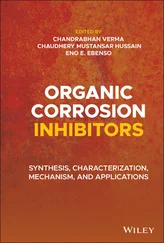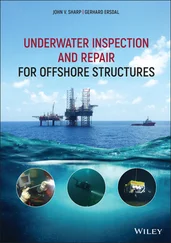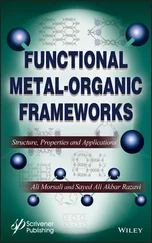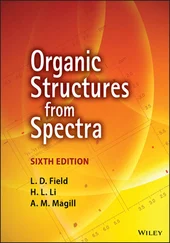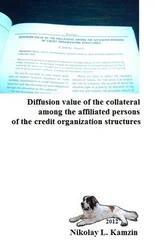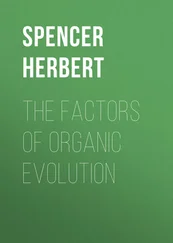Introduction: A Brief Introduction About Metal-Organic Frameworks
Abstract
Metal-organic frameworks (MOFs) or porous coordination polymers (PCPs) are a subset of hybrid porous materials that have recently attracted considerable attention. Their structures are constructed from inorganic (such as metal clusters or atoms, rod-shaped clusters) and organic (such as carboxylates, azoles, nitriles) parts with different chemical nature. The features of both parts (node and linker) can determine MOF properties like network structure (net) topology, physical, mechanical and morphological features. MOFs with tunable pore size, different functionalization, high surface area and stability can be synthesized through the various synthesis methods. Depending on application of MOFs, design and their synthetic methods can be changed that are very important. Indeed, the rise of MOFs chemistry can be primarily related to their properties and performances. In this chapter, we present a brief introduction about MOFs such as types of metal nodes, organic linkers and synthesis strategies. So, based on the used components in MOFs, diverse frameworks can be designed and generated. As a result, tunability in their structure makes them attractive and important candidates for diverse purposes.
Keywords:Metal-organic framework, inorganic building units, organic linkers, structural tunability, porous materials
1.1 Metal-Organic Frameworks
Over almost 20 years, many investigations have been performed about the porous materials field especially metal-organic frameworks (MOFs) as a subset of porous coordination polymers (PCPs). For the first time, these compounds were defined by Yaghi and co-workers in 1995. The considerable attention to MOFs is due to their chemical and physical properties such as variety in building units and design, pore size, and cavity shape that lead to different frameworks with diverse applications. In the growth of these compounds and their introduction, several scientific groups are trying. The most important and famous MOFs are MOF-5 (zinc salt and H 2BDC), HKUST-1 (copper salt and H 3BTC), MIL-101 (chromium/iron salt and H 2BDC), and MOF-74 (zinc salt and H 2-DHBDC). As known, the reticular structures of MOFs can be made from two sections: inorganic nodes and organic linkers (sometimes with functional group). Simple description of 3D MOF chemistry has been shown in Figure 1.1.
Diverse building blocks can be used in the synthesis of any MOF, for example, metal units as node including lanthanide cations, transition metals, heavy transition metals and main metal ions, organic linkers like carboxylates linkers, and N-donor ligands that can be ditopic or polytopic. So, unlimited number of frameworks can be created with different features, geometries, and structures. Whereas, these components as building blocks can affect MOFs properties, so they should be carefully selected. In the following, we show some examples of SBUs (secondary building units), linkers, and MOFs although there are the various building units ( Figure 1.2) [1, 2].
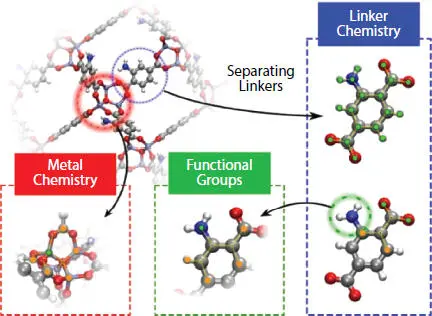
Figure 1.1 Simple description of 3D MOF chemistry [1].
It is worthy to note that stability and instability of MOFs are closely related to the used components and their coordination bonding (between metal moiety and organic linker). In the construction of these PCPs with crystalline networks, the coordination bonds are formed between building units. They have desirable features such as large surface area, adjustable pores, appropriate porosity, and crystalline structure with different topologies [3–5]. In addition, the body of MOFs, from metal nodes to linkers, can be functionalized with various functional groups through different strategies such as incorporation of the intended groups by post-synthesis modification (PSM) as straightforward approach. The ideal tunability in MOFs constituents leads to various platforms with different applications even in the industrial scale as catalysis, gas storage, supercapacitors, medical uses, separation, sensing, and so on. In fact, owing to the facile ability to functionalize such materials, MOFs have found suitability for a range of applications. Certainly, there are some difficulties and limitations to prepare the plausible nets of MOFs such as temperature, solvent, stability, geometry building blocks, kind of the used metal/ligand, and their solubility. Nowadays, new ideas and valuable efforts have been aimed to the successful synthesis of new MOFs with remarkable designs and useful properties, because MOFs have the desirable potential due to the flexibility in choosing the structural components. Until now, different approaches to synthesize porous MOFs have been generally reported such as solvothermal or sonochemical syntheses. But, day to day, the development in new or optimized synthetic methodologies accelerates the creation of new structures with different features. As an example, Hwang et al . reported the different synthetic methods in Fe-BTC hydrothermal synthesis based on change in time or temperature reaction, or Yang et al . presented conditions of hydrothermal synthesis in the generation of HKUST-1 based on change in time and solvent. Some synthesis methods have been introduced in Figure 1.3. In all of them, the optimal conditions of synthesis methods have been investigated with their advantages and disadvantages. However, MOFs can be easily manipulated and modified by the adjustment of the components and synthesis conditions [6–15]. Indeed, their consistuents enable the preparation of different frameworks with various sizes through a broad spectrum of synthetic methods like solvothermal (such as hydrothermal synthesis: it refers to synthesis through chemical reactions in an aqueous solution above the boiling point of water), electrochemical method (direct or indirect synthesis; Unlike indirect synthesis, in which electrochemistry is only a step in an overall synthesis method, direct route allows synthesis rate control by electrochemical means) [16–19], sonochemical synthesis (using powerful ultrasound radiation (20 kHz–10 MHz)), [20, 21] mechanochemical synthesis (a processing method of solids in which mechanical and chemical phenomena are coupled on a molecular scale) and so on [22–24]. As mentioned, depending on the synthesis conditions and compositions, properties of MOF can be changed toward new and modified features. So, structural flexibility and diversity of MOFs that can be originated from synthetic methods can promote and improve frameworks and their applications. For example, the combination of 1,4-benzenedicarboxylate and Zn leads to 1D linear structure. It is interesting that 2D layered structure and 3D network can be also produced by using these starting materials through interactions such as hydrogen bond and π-π stacking [25, 26]. So, due to a great number of metal nodes and organic linkers, designed new well-defined MOFs through different syntheses can be created. Most porous MOFs have homogeneous structures without any heterogeneity or complexity in their structure. The term of “complexity” in materials has received a great deal of attention in scientific fields. However, complexity in systems has a long history in science. In this book, we introduce some effective factors in the production of heterogeneous structures of MOFs by their structural complexity and heterogeneity. Certainly, book chapters can provide creativity for new research and describe a number of significant and different up-to-date strategies about the generation of complex MOFs.
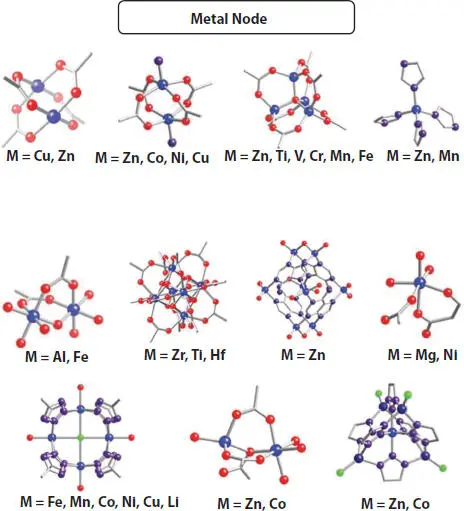
Figure 1.2 Some examples of metal nodes, organic linkers, and MOFs (definition of atom types: blue: metal; red: oxygen; purple: nitrogen; gray: carbon; and green: chlorine).
Читать дальше





